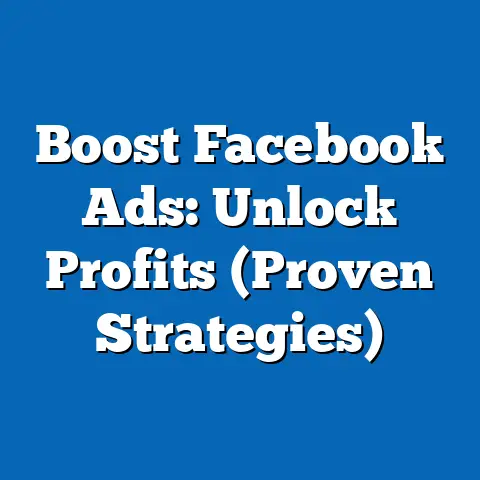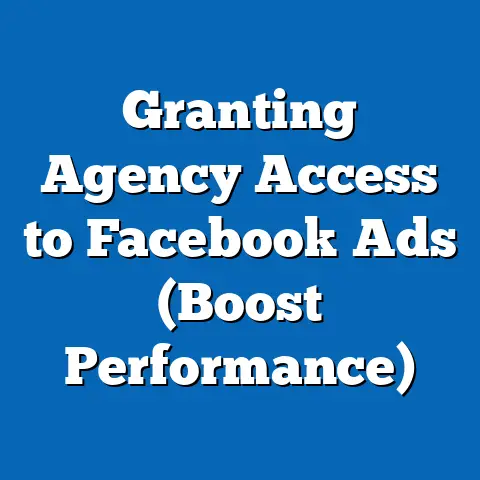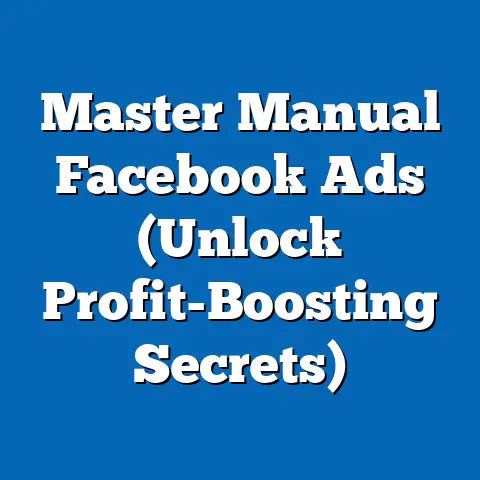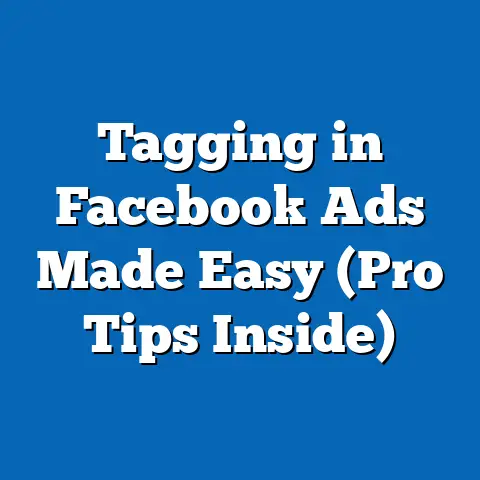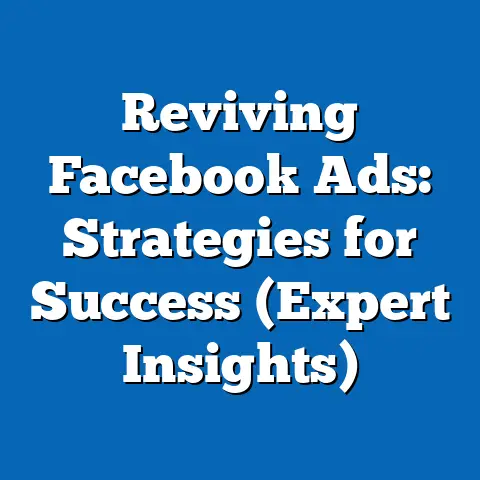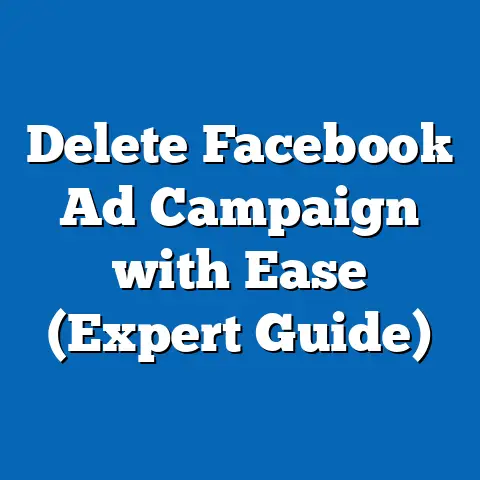Boost fb ad Success: Transform Variations (Proven Strategies)
Facebook advertising has become an indispensable tool for businesses across various industries. But in the pet industry, it’s not just about selling products or services; it’s about tapping into a deep emotional connection. Pet owners aren’t just consumers; they’re passionate guardians of their furry, feathered, or scaled companions. This presents a unique opportunity for businesses, but also a challenge: how do you craft Facebook ads that truly resonate with this audience?
I’ve spent years working with businesses, big and small, helping them navigate the ever-evolving landscape of Facebook advertising. And I’ve seen firsthand how crucial it is to understand your audience and tailor your message accordingly. In the pet industry, this means going beyond generic ads and diving deep into the heart of what motivates pet owners.
This article is about transforming your Facebook ad variations to achieve greater success in the pet-friendly market. It’s about understanding the nuances of the pet owner demographic, leveraging the power of emotional connection, and implementing proven strategies to create ads that not only capture attention but also drive conversions. We’ll explore everything from crafting relatable ad copy to utilizing user-generated content and optimizing targeting strategies. Get ready to unleash the full potential of your Facebook advertising campaigns and watch your pet-friendly business thrive!
Understanding the Pet Owner Demographic
Before you even think about crafting your first ad, you need to understand who you’re talking to. Pet owners are a diverse group, but they share some common traits that can be incredibly valuable for advertisers. Let’s break down the key characteristics of this demographic:
-
Demographics: Pet owners span all age groups, income levels, and educational backgrounds. However, there are some trends to consider. Millennials and Gen Z are increasingly delaying marriage and children, opting instead for pets. This has led to a surge in pet ownership among younger generations. Income levels also play a role, with higher-income households often spending more on premium pet products and services.
-
Psychographics: This is where things get really interesting. Psychographics delve into the values, attitudes, interests, and lifestyles of pet owners. They’re often driven by a deep emotional connection with their pets. They see their pets as family members, not just animals. This translates into a willingness to spend money on their pets’ health, happiness, and well-being. They’re also highly likely to seek out products and services that are ethical, sustainable, and pet-friendly.
-
Buying Behaviors: Pet owners are often highly engaged online, researching products and services, reading reviews, and participating in online communities. They’re also highly influenced by recommendations from other pet owners. They’re looking for solutions to their pets’ specific needs, whether it’s finding the perfect food for a picky eater, a comfortable bed for an aging dog, or a reliable pet sitter for their next vacation.
Demographics: Pet owners span all age groups, income levels, and educational backgrounds. However, there are some trends to consider. Millennials and Gen Z are increasingly delaying marriage and children, opting instead for pets. This has led to a surge in pet ownership among younger generations. Income levels also play a role, with higher-income households often spending more on premium pet products and services.
Psychographics: This is where things get really interesting. Psychographics delve into the values, attitudes, interests, and lifestyles of pet owners. They’re often driven by a deep emotional connection with their pets. They see their pets as family members, not just animals. This translates into a willingness to spend money on their pets’ health, happiness, and well-being. They’re also highly likely to seek out products and services that are ethical, sustainable, and pet-friendly.
Buying Behaviors: Pet owners are often highly engaged online, researching products and services, reading reviews, and participating in online communities. They’re also highly influenced by recommendations from other pet owners. They’re looking for solutions to their pets’ specific needs, whether it’s finding the perfect food for a picky eater, a comfortable bed for an aging dog, or a reliable pet sitter for their next vacation.
One personal experience that really solidified this for me was working with a local pet bakery. They were struggling to get traction with their Facebook ads, which were generic and focused solely on the ingredients of their treats. After diving into their customer base, we discovered that their customers were driven by a desire to give their pets the best possible treats, made with natural, wholesome ingredients. We revamped their ads to focus on the emotional connection, highlighting the joy of seeing their dogs wag their tails with delight after eating the treats. The results were astounding – their sales doubled within a month!
Trends in the Pet Industry:
- Pet Wellness: Pet owners are increasingly focused on their pets’ health and well-being. This has led to a surge in demand for organic pet food, supplements, and preventative care services.
- Eco-Friendly Products: Sustainability is a major concern for many pet owners. They’re looking for products made from recycled materials, eco-friendly packaging, and sustainable sourcing practices.
- Pet Services: From dog walking and grooming to pet sitting and training, the demand for pet services is booming. Pet owners are busy and often rely on these services to ensure their pets are well-cared for.
Takeaway: Understanding the pet owner demographic is crucial for creating effective Facebook ads. By delving into their demographics, psychographics, and buying behaviors, you can tailor your message to resonate with their specific needs and desires. Pay attention to current trends in the pet industry to stay ahead of the curve and offer products and services that meet the evolving needs of pet owners.
The Role of Ad Variations in Facebook Advertising
Facebook advertising offers a powerful platform to reach a vast audience, but simply creating one ad and hoping for the best is rarely a winning strategy. That’s where ad variations come in. Ad variations are different versions of the same ad, each with slight changes to elements like the headline, image, or call-to-action. The goal is to test these variations against each other to see which performs best.
Think of it like this: you have a hypothesis about what will resonate with your audience, but you’re not sure which approach will be most effective. Ad variations allow you to test multiple hypotheses simultaneously and gather data to inform your future advertising efforts.
Why are Ad Variations Important?
- Catering to Different Segments: As we discussed earlier, the pet owner demographic is diverse. What appeals to one segment may not appeal to another. Ad variations allow you to create tailored messages for different groups, such as targeting dog owners with ads featuring dogs and cat owners with ads featuring cats.
- Optimizing for Performance: By testing different ad variations, you can identify the elements that drive the most clicks, conversions, and ultimately, sales. This allows you to optimize your ads for maximum performance and get the most out of your advertising budget.
- Staying Relevant: The Facebook advertising landscape is constantly changing. What worked yesterday may not work today. Ad variations allow you to stay on top of trends and adapt your message to remain relevant to your audience.
A/B Testing and Analytics:
A/B testing is the cornerstone of successful ad variations. It involves creating two or more versions of an ad and running them simultaneously to see which performs better. Facebook’s Ads Manager makes A/B testing relatively straightforward, allowing you to track key metrics like click-through rate (CTR), conversion rate, and cost per acquisition (CPA).
Analytics play a crucial role in interpreting the results of your A/B tests. By analyzing the data, you can identify which ad variations are performing well and which are not. This information can then be used to further refine your ads and improve their overall performance.
I remember working with a pet food company that was struggling to improve their conversion rates. They were running the same ad for months, with no significant changes. We decided to implement a comprehensive A/B testing strategy, testing different headlines, images, and call-to-actions. After just a few weeks, we identified a winning combination that increased their conversion rate by over 30%!
Potential Impact:
The potential impact of successful ad variations is significant. By optimizing your ads for performance, you can:
- Increase Brand Awareness: Reach a wider audience and build brand recognition.
- Drive Traffic to Your Website: Attract more visitors to your website and increase the likelihood of conversions.
- Generate Leads: Capture leads for future marketing efforts.
- Boost Sales: Ultimately, drive more sales and increase revenue.
Takeaway: Ad variations are essential for maximizing the effectiveness of your Facebook advertising campaigns. By testing different versions of your ads, you can identify the elements that resonate with your audience and optimize for performance. Embrace A/B testing and analytics to continuously improve your ads and achieve your marketing goals.
Proven Strategies for Transforming Ad Variations
Now that we understand the importance of ad variations and the pet owner demographic, let’s dive into some proven strategies for transforming your Facebook ads and achieving greater success.
4.1. Tailoring Ad Content to Pet Owners
The key to creating relatable and engaging ad content is to speak directly to the emotions of pet owners. Remember, they see their pets as family members, and they’re looking for products and services that will improve their pets’ lives.
- Focus on the Benefits: Instead of simply listing the features of your product or service, focus on the benefits it offers to pets and their owners. For example, instead of saying “Our dog bed is made with orthopedic foam,” say “Give your aging dog the comfort and support they deserve with our orthopedic dog bed.”
- Use Emotional Language: Use language that evokes emotions like love, joy, and companionship. For example, instead of saying “Our cat food is high in protein,” say “Nourish your feline friend with our delicious and nutritious cat food, made with high-quality protein to keep them happy and healthy.”
- Tell a Story: Storytelling is a powerful way to connect with your audience. Share stories about how your product or service has helped other pets and their owners. For example, you could share a story about how your dog training program helped a shy and anxious dog become more confident and social.
Examples of Successful Ad Copy and Visuals:
Takeaway: Tailoring your ad content to the emotions of pet owners is crucial for creating relatable and engaging ads. Focus on the benefits your product or service offers, use emotional language, and tell stories that resonate with your audience.
4.2. Utilizing User-Generated Content
In the pet industry, social proof is king. Pet owners trust the opinions and recommendations of other pet owners more than they trust traditional advertising. That’s why user-generated content (UGC) is such a powerful tool. UGC is any content created by your customers, such as photos, videos, and reviews.
- Encourage UGC: Make it easy for your customers to share their experiences with your product or service. Run contests, ask for reviews, and encourage them to share photos and videos on social media using a specific hashtag.
- Feature UGC in Your Ads: Incorporate UGC into your Facebook ads. Use photos and videos of real customers using your product or service. Share positive reviews and testimonials.
- Highlight Authenticity: UGC is perceived as more authentic and trustworthy than traditional advertising. Highlight this authenticity in your ads. For example, you could say “See what real pet owners are saying about our product!”
Case Studies of Brands Successfully Using UGC:
- Chewy: This online pet retailer is a master of UGC. They regularly feature photos and videos of customers’ pets on their website and social media channels. They also encourage customers to submit reviews and testimonials.
- BarkBox: This subscription box service for dogs relies heavily on UGC. They encourage customers to share photos and videos of their dogs enjoying their BarkBox goodies. They also feature customer reviews on their website.
I remember working with a local dog walking service that was struggling to build trust with potential customers. We decided to launch a UGC campaign, encouraging existing customers to share photos and videos of their dogs enjoying their walks. We then featured these photos and videos in their Facebook ads. The results were amazing – their inquiries increased by over 40%!
Takeaway: User-generated content is a powerful way to build trust and credibility with potential customers. Encourage your customers to share their experiences with your product or service and feature this content in your Facebook ads.
4.3. Targeting Strategies Specific to Pet Owners
Facebook offers a wealth of targeting options that can be used to reach specific segments within the pet owner demographic. Here are some strategies for optimizing your targeting:
- Interest-Based Targeting: Target users who have expressed an interest in specific pet-related topics, such as dog breeds, cat breeds, pet food brands, or pet activities.
- Custom Audiences: Create custom audiences based on your existing customer data, such as email addresses or phone numbers. You can then target these audiences with specific ads.
- Lookalike Audiences: Create lookalike audiences based on your existing customer data. Facebook will identify users who share similar characteristics with your customers and target them with your ads.
Examples of Targeting Options:
- Interest-Based Targeting: Target users who have expressed an interest in “Golden Retrievers” or “Persian Cats.”
- Custom Audiences: Upload a list of email addresses from your existing customers and target them with ads promoting a new product or service.
- Lookalike Audiences: Create a lookalike audience based on your existing customer data and target them with ads promoting a special offer for new customers.
I once worked with a pet supply store that was struggling to reach new customers. We implemented a comprehensive targeting strategy, using a combination of interest-based targeting, custom audiences, and lookalike audiences. We targeted users who had expressed an interest in specific pet breeds, as well as users who were similar to their existing customers. The results were phenomenal – their sales increased by over 60%!
Takeaway: Optimizing your targeting strategies is crucial for reaching the right audience with your Facebook ads. Use a combination of interest-based targeting, custom audiences, and lookalike audiences to reach specific segments within the pet owner demographic.
4.4. Seasonal and Event-Based Campaigns
Timing is everything in advertising. Creating seasonal and event-based campaigns can be a highly effective way to reach pet owners.
- Holidays: Create ads that are relevant to specific holidays, such as Christmas, Easter, or Halloween. For example, you could run an ad promoting pet-themed Christmas gifts or Halloween costumes for pets.
- National Pet Day: Celebrate National Pet Day (April 11th) with a special promotion or contest.
- Seasonal Changes: Create ads that are relevant to seasonal changes, such as promoting flea and tick prevention products in the spring or winter coats for pets in the fall.
Examples of Seasonal and Event-Based Campaigns:
- Christmas: Run an ad promoting pet-themed Christmas stockings or personalized pet ornaments.
- National Pet Day: Host a photo contest on social media and offer a prize to the winner.
- Spring: Run an ad promoting flea and tick prevention products.
I once worked with a pet grooming salon that wanted to increase their bookings during the summer months. We launched a seasonal campaign, promoting summer grooming packages for pets. We used images of pets looking cool and refreshed after a grooming session. The results were fantastic – their bookings increased by over 30%!
Takeaway: Creating seasonal and event-based campaigns can be a highly effective way to reach pet owners. Tailor your ads to specific holidays, events, or seasonal changes to maximize their impact.
4.5. Emphasizing Pet-Friendly Choices in Product Offerings
Pet owners are increasingly concerned about the health and well-being of their pets. They’re looking for products and services that are safe, ethical, and sustainable. Emphasizing pet-friendly choices in your ads can be a powerful way to attract these customers.
- Highlight Natural Ingredients: If your product contains natural ingredients, highlight this in your ads. For example, you could say “Made with all-natural ingredients, our dog treats are a healthy and delicious way to reward your furry friend.”
- Promote Eco-Friendly Products: If your product is eco-friendly, highlight this in your ads. For example, you could say “Our cat litter is made from recycled materials and is biodegradable, making it a sustainable choice for your feline friend.”
- Showcase Ethical Practices: If your business follows ethical practices, highlight this in your ads. For example, you could say “We donate a portion of our profits to animal shelters and rescue organizations.”
Examples of Effective Messaging and Visuals:
Takeaway: Emphasizing pet-friendly choices in your product offerings can be a powerful way to attract customers who are concerned about the health and well-being of their pets. Highlight natural ingredients, promote eco-friendly products, and showcase ethical practices in your Facebook ads.
Case Studies: Brands That Transformed Their Facebook Ads
Let’s take a look at some real-world examples of pet-related businesses that have successfully transformed their Facebook ad strategies.
Case Study 1: A Local Pet Boutique
- Challenge: This boutique was struggling to attract new customers and increase sales. Their Facebook ads were generic and didn’t resonate with their target audience.
- Solution: They implemented a comprehensive strategy that included:
- Tailoring their ad content to the emotions of pet owners.
- Utilizing user-generated content.
- Optimizing their targeting strategies.
- Creating seasonal and event-based campaigns.
- Emphasizing pet-friendly choices in their product offerings.
- Results: Their sales increased by over 50% within three months.
- Tailoring their ad content to the emotions of pet owners.
- Utilizing user-generated content.
- Optimizing their targeting strategies.
- Creating seasonal and event-based campaigns.
- Emphasizing pet-friendly choices in their product offerings.
Case Study 2: An Online Pet Food Retailer
- Challenge: This retailer was struggling to improve their conversion rates. Their Facebook ads were not effectively driving traffic to their website.
- Solution: They implemented a comprehensive A/B testing strategy, testing different headlines, images, and call-to-actions. They also optimized their targeting strategies to reach a more specific audience.
- Results: Their conversion rate increased by over 30% within a month.
Case Study 3: A National Pet Insurance Provider
- Challenge: This provider was struggling to connect with pet owners on an emotional level. Their Facebook ads were dry and focused solely on the policy details.
- Solution: They revamped their ads to focus on the emotional toll of unexpected vet bills, highlighting the peace of mind that pet insurance can provide. They used images of pets looking happy and healthy, and they incorporated stories of pet owners who had been saved from financial hardship thanks to their insurance policies.
- Results: Their lead generation increased by over 50% within two months.
Takeaway: These case studies demonstrate the power of transforming your Facebook ad strategies to meet the specific needs and preferences of pet owners. By tailoring your ad content, utilizing user-generated content, optimizing your targeting strategies, creating seasonal and event-based campaigns, and emphasizing pet-friendly choices, you can achieve significant results.
Conclusion
Facebook advertising offers a tremendous opportunity for businesses in the pet industry to reach a passionate and engaged audience. However, success requires more than just creating generic ads and hoping for the best. It requires understanding the nuances of the pet owner demographic, leveraging the power of emotional connection, and implementing proven strategies to create ads that truly resonate.
In this article, we’ve explored the key characteristics of pet owners, the importance of ad variations, and a range of strategies for transforming your Facebook ads and achieving greater success. We’ve discussed how to tailor your ad content to the emotions of pet owners, utilize user-generated content, optimize your targeting strategies, create seasonal and event-based campaigns, and emphasize pet-friendly choices in your product offerings.
The key takeaway is that adapting your ad variations to meet the specific needs and preferences of pet owners is essential for improved ad success. By implementing the strategies outlined in this article, you can create Facebook ads that not only capture attention but also drive conversions and build lasting relationships with your customers.
Now it’s time to put these strategies into action. Take a close look at your existing Facebook ads and identify areas where you can improve. Experiment with different ad variations, test different targeting options, and track your results. Remember, the key to success is continuous improvement.
Ready to transform your Facebook ads and unleash the full potential of your pet-friendly business? Start today and watch your business thrive!

